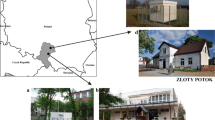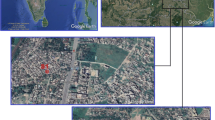Abstract
As children represent one of the most vulnerable groups in society, more information concerning their exposure to health hazardous air pollutants in school environments is necessary. Polycyclic aromatic hydrocarbons (PAHs) have been identified as priority air pollutants due to their mutagenic and carcinogenic properties that strongly affect human health. Thus, this work aims to characterize levels of 18 selected PAHs in preschool environment, and to estimate exposure and assess the respective risks for 3–5-year-old children (in comparison with adults). Gaseous PAHs (mean of 44.5 ± 12.3 ng m−3) accounted for 87 % of the total concentration (ΣPAHs) with 3–ringed compounds being the most abundant (66 % of gaseous ΣPAHs). PAHs with 5 rings were the most abundant ones in the particulate phase (PM; mean of 6.89 ± 2.85 ng m−3) being predominantly found in PM1 (78 % particulate ΣPAHs). Overall child exposures to PAHs were not significantly different between older children (4–5 years old) and younger ones (3 years old). Total carcinogenic risks due to particulate-bound PAHs indoors were higher than outdoor ones. The estimated cancer risks of both preschool children and the staff were lower than the United States Environmental Protection Agency (USEPA) threshold of 10−6 but slightly higher than WHO-based guideline.

Similar content being viewed by others
References
Alves CA, Urban RC, Pegas PN, Nunes T (2014) Indoor/outdoor relationships between PM10 and associated organic compounds in a primary school. Aerosol Air Qual Res 14:86–98
Annesi-Maesano I, Moreau D, Caillaud D, Lavaud F, Le Moullec Y, Taytard A, Pauli G, Charpin D (2007) Residential proximity fine particles related to allergic sensitisation and asthma in primary school children. Respir Med 101:1721–1729
Bae S, Pan X-C, Kim S-Y, Park K, Kim Y-H, Kim H, Hong Y-C (2010) Exposures to particulate matter and polycyclic aromatic hydrocarbons and oxidative stress in schoolchildren. Environ Health Perspect 118:579–583
Boström CE, Gerde P, Hanberg A, Jernstrom B, Johansson C, Kyrklund T, Rannug A, Tornqvist M, Victorin K, Westerholm R (2002) Cancer risk assessments, indicators, and guidelines for polycyclic aromatic hydrocarbons in the ambient air. Environ Health Perspect 10:451–488
Burtscher H, Schüepp K (2012) The occurrence of ultrafine particles in the specific environment of children. Paediatr Respir Rev 13(2):89–94
Castro D, Slezakova K, Oliva–Teles MT, Delerue–Matos C, Alvim–Ferraz MC, Morais S, Pereira MC (2009) Analysis of polycyclic aromatic hydrocarbons in atmospheric particulate samples by microwave-assisted extraction and liquid chromatography. J Sep Sci 32:501–510
Castro D, Slezakova K, Delerue–Matos C, Alvim–Ferraz M, Morais S, Pereira MC (2011) Polycyclic aromatic hydrocarbons in gas and particulate phases of indoor environment influenced by tobacco smoke: levels, phase distribution and health risks. Atmos Environ 45:1799–1808
Chen C, Zhao B, Zhou WT, Jiang XY, Tan ZC (2012) A methodology for predicting particle penetration factor through cracks of windows and doors for actual engineering application. Build Environ 47:339–348
Cirillo T, Montuori P, Mainardi P, Russo I, Triassi M, Amodio-Cocchieri R (2006) Multipathway polycyclic aromatic hydrocarbon and pyrene exposure among children living in Campania (Italy). J Environ Sci Health A Tox Hazard Subst Environ Eng 41:2089–2107
Cohen Hubal EA, Sheldon LS, Burke JM, McCurdy TR, Berry MR, Rigas ML, Zartarian VG, Freeman NC (2000) Children’s exposure assessment: a review of factors influencing children’s exposure, and the data available to characterize and assess that exposure. Environ Health Perspect 108(6):475–486
Edwards RD, Schweize C, Llacqua V, Lai HK, Jantunen M, Bayer-Oglesby L, Künzli N (2006) Time–activity relationships to VOC personal exposure factors. Atmos Environ 40:5685–5700
Gatto MP, Gariazzo C, Gordian A, L’Episcopo N, Gherardi M (2014) Children and elders exposure assessment to particle-bound polycyclic aromatic hydrocarbons (PAHs) in the city of Rome, Italy. Environ Sci Pollut Res 21:13152–13159
Guo Y, Wu K, Huo X, Xu X (2011) Sources, distribution, and toxicity of polycyclic aromatic hydrocarbons. J Environ Health 73:2–25
Hanedar A, Alp K, Kaynak B, Avşar E (2014) Toxicity evaluation and source apportionment of polycyclic aromatic hydrocarbons (PAHs) at three stations in Istanbul, Turkey. Sci Total Environ 488–489:437–446
IARC Working Group on the Evaluation of Carcinogenic Risks to Humans (2002) Some traditional herbal medicines, some mycotoxins, naphthalene and styrene. IARC Monogr Eval Carcinog Risks Hum 82:1–556
IARC Working Group on the Evaluation of Carcinogenic Risks to Humans (2010) Some non-heterocyclic polycyclic aromatic hydrocarbons and some related exposures. IARC Monogr Eval Carcinog Risks Hum 92:1–853
Jyethi DS, Khillare PS, Sarkar S (2014) Risk assessment of inhalation exposure to polycyclic aromatic hydrocarbons in school children. Environ Sci Pollut Res 21:366–378
Kalaiarasan M, Balasubramanian R, Cheong KWD, Tham KW (2009) Traffic-generated airborne particles in naturally ventilated multi-storey residential buildings of Singapore: vertical distribution and potential health risks. Build Environ 44(7):1493–1500
Kim KH, Jahan SA, Kabir E, Brown RJ (2013) A review of airborne polycyclic aromatic hydrocarbons (PAHs) and their human health effects. Environ Int 60:71–80
Klejnowski K, Kozielska B, Krasa A, Rogula-Kozlowska W (2010) Polycyclic aromatic hydrocarbons in PM1, PM2.5, PM10 and TSP in the upper Silesian agglomeration. Poland Arch Environ Prot 36:65–72
Krugly E, Martuzevicius D, Sidaraviciute R, Ciuzas D, Prasauskas T, Kauneliene V, Stasiulaitiene I, Kliucininkas L (2014) Characterization of particulate and vapor phase polycyclic aromatic hydrocarbons in indoor and outdoor air of primary schools. Atmos Environ 82:298–306
Ladji R, Yassaa N, Balducci C, Cecinato A (2014) Particle size distribution of n-alkanes and polycyclic aromatic hydrocarbons (PAHS) in urban and industrial aerosol of Algiers, Algeria. Environ Sci Pollut Res 21:1819–1832
Miller JN, Miller JC (2000) Statistics for analytical chemistry. Pearson Education Ltd., Harlow
Moshammer H, Neuberger M (2003) The active surface of suspended particles as a predictor of lung function and pulmonary symptoms in Austrian school children. Atmos Environ 37:1737–1744
Okona-Mensah KW, Battershill J, Boobis A, Fielder R (2005) An approach to investigating the importance of high potency polycyclic aromatic hydrocarbons (PAHs) in the induction of lung cancer by air pollution. Food Chem Toxicol 43:1103–1116
Qi H, Li W-L, Zhu N-Z, Ma W-L, Liu L-Y, Zhang F, Li Y-F (2014) Concentrations and sources of polycyclic aromatic hydrocarbons in indoor dust in China. Sci Total Environ 491–492:100–107
Ravindra K, Sokh R, Grieken RV (2008) Atmospheric polycyclic aromatic hydrocarbons: source attribution, emission factors and regulation. Atmos Environ 42:2895–2921
Ruchirawat M, Navasumrit P, Settachan D, Autrup H (2006) Environmental impacts on children’s health in Southeast Asia: genotoxic compounds in urban air. Ann N Y Acad Sci 1076:678–690
Ruchirawat M, Settachan D, Navasumrit P, Tuntawiroon J, Autrup H (2007) Assessment of potential cancer risk in children exposed to urban air pollution in Bangkok, Thailand. Toxicol Lett 168:200–209
Saravia J, Lee GI, Lomnicki S, Dellinger B, Cormier SA (2013) Particulate matter containing environmentally persistent free radicals and adverse infant respiratory health effects: a review. J Biochem Mol Toxicol 27:56–68
Schüepp K, Sly PD (2012) The developing respiratory tract and its specific needs in regard to ultrafine particulate matter exposure. Paediatr Respir Rev 13(2):95–99
Schwab M, McDermot A, Spengler JD (1992) Using longitudinal data to understand children's activity patterns in an exposure context: data from the Kanawha County Health Study. Environ Int 18(2):173–189
Shen G, Wei S, Zhang Y, Wang R, Wang B, Li W, Shen H, Huang Y, Chen Y, Chen H, Wei W, Tao S (2012) Emission of oxygenated polycyclic aromatic hydrocarbons from biomass pellet burning in a modern burner for cooking in China. Atmos Environ 60:234–237
Slezakova K, Castro D, Begonha A, Delerue-Matos C, Alvim-Ferraz MC, Morais S, Pereira MC (2011) Air pollution from traffic emissions in Oporto, Portugal: health and environmental implications. Microchem J 99:51–59
Slezakova K, Pires JCM, Castro D, Alvim-Ferraz MC, Delerue-Matos C, Morais S, Pereira MC (2013a) PAH air pollution at a Portuguese urban area: carcinogenic risks and sources identification. Environ Sci Pollut Res 20:3932–3945
Slezakova K, Castro D, Delerue-Matos C, Alvim-Ferraz MC, Morais S, Pereira MC (2013b) Impact of vehicular traffic emissions on particulate-bound PAHs: levels and associated health risks. Atmos Res 127:141–147
Slezakova K, Castro D, Delerue-Matos C, Morais S, Pereira MC (2014) Levels and risks of particulate-bound PAHs in indoor air influenced by tobacco smoke: a field measurement. Environ Sci Pollut Res 21:4492–4501
Tuntawiroon J, Mahidol C, Navasumrit P, Autrup H, Ruchirawat M (2007) Increased health risk in Bangkok children exposed to polycyclic aromatic hydrocarbons from traffic-related sources. Carcinogenesis 28:816–822
United States Environmental Protection Agency (USEPA) (1989) Risk assessment guidance for superfund, vol. I: human health evaluation manual. EPA/540/1–89/002. Office of Emergency and Remedial Response, Washington, DC
United States Environmental Protection Agency (USEPA) (2011) Exposure factors handbook 2011 edition (final). United States Environmental Protection Agency, Washington, DC
United States Environmental Protection Agency (USEPA) (2014) Risk–based concentration table. http://www.epa.gov/reg3hwmd/risk/human/rb-concentration_table/usersguide.htm. Accessed 26 October 2014
Wilson NK, Chuang JC, Lyu C, Menton R, Morgan MK (2003) Aggregate exposures of nine preschool children to persistent organic pollutants at day care and at home. J Expo Anal Environ Epidemiol 13:187–202
World Health Organization (2010) WHO guidelines for indoor air quality: selected pollutants. Regional Office for Europe of the World Health Organization, Copenhagen
World Health Organization (2013) State of the science of endocrine disrupting chemicals 2012. United Nations Environment Programme and the World Health Organization, Geneva
Acknowledgments
This work was supported by Fundação para Ciência e Tecnologia through fellowships SFRH/BD/80113/2011 and SFRH/BPD/65722/2009. It also received financial support from the European Union (FEDER funds through COMPETE) and National Funds (Fundação para a Ciência e Tecnologia) through projects Pest-C/EQB/LA0006/2013 and PEst-C/EQB/UI0511/2013.
Author information
Authors and Affiliations
Corresponding author
Additional information
Responsible editor: Ester Heath
Electronic supplementary material
Below is the link to the electronic supplementary material.
Table S1
(DOCX 27.8 kb)
Rights and permissions
About this article
Cite this article
Oliveira, M., Slezakova, K., Delerue-Matos, C. et al. Exposure to polycyclic aromatic hydrocarbons and assessment of potential risks in preschool children. Environ Sci Pollut Res 22, 13892–13902 (2015). https://doi.org/10.1007/s11356-015-4588-2
Received:
Accepted:
Published:
Issue Date:
DOI: https://doi.org/10.1007/s11356-015-4588-2




